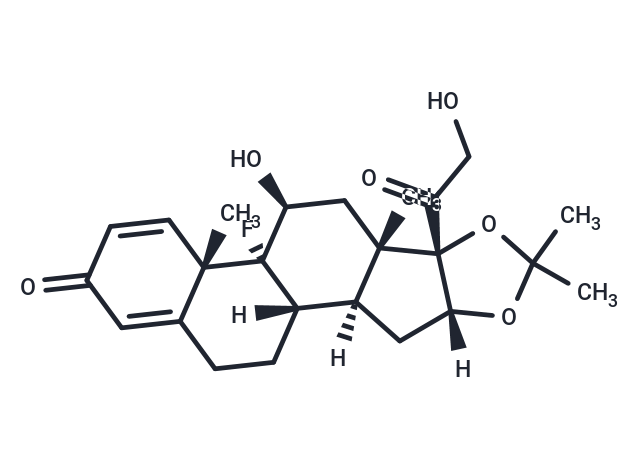Shopping Cart
Remove All Your shopping cart is currently empty
Your shopping cart is currently empty
Triamcinolone acetonide (Azmacort) is a Corticosteroid. The mechanism of action of triamcinolone acetonide is as a Corticosteroid Hormone Receptor Agonist. It is an anti-inflammatory glucocorticoid used topically in the treatment of various skin disorders. Intralesional, intramuscular, and intra-articular injections are also administered under certain conditions.

| Pack Size | Price | USA Warehouse | Global Warehouse | Quantity |
|---|---|---|---|---|
| 50 mg | $29 | In Stock | In Stock | |
| 1 mL x 10 mM (in DMSO) | $50 | In Stock | In Stock |
| Description | Triamcinolone acetonide (Azmacort) is a Corticosteroid. The mechanism of action of triamcinolone acetonide is as a Corticosteroid Hormone Receptor Agonist. It is an anti-inflammatory glucocorticoid used topically in the treatment of various skin disorders. Intralesional, intramuscular, and intra-articular injections are also administered under certain conditions. |
| In vitro | In horses subjected to a second injection of lipopolysaccharide, Triamcinolone Acetonide reduced edema, lameness, and joint fluid protein concentration. In mice, Triamcinolone Acetonide, a synthetic glucocorticoid, induced cleft palate resulting from impaired palatal development. In the jaws of rat embryos, Triamcinolone Acetonide inhibited the proliferation of mesenchymal cells and affected the differentiation of MEE (Medial Edge Epithelium) cells into stratified squamous epithelial cells. Compared to methoxycarbonyl alone, Triamcinolone Acetonide increased both the white blood cell count and methoxycarbonyl concentration in the synovial fluid. |
| In vivo | Triamcinolone Acetonide reduced polysaccharide synthesis and increased the glycosaminoglycan (GAG) content in the culture medium compared to the blank group and IL-1 group. It also augmented GAG degradation. This compound significantly decreased the paracellular permeability of ECV304 cells and downregulated ICAM-1 expression, corroborating with immunocytochemical observations. In rat retinas, Triamcinolone reversed Müller glial cell swelling, a phenomenon observed under various experimental conditions: in retinas isolated 3 days post-transient retinal ischemia, in control retinas with 1 mM Ba^2+, 10 μM arachidonic acid, 200 μM H2O2, or 30 nM prostaglandin E2, and in retinas with lipopolysaccharide-induced ocular inflammation. |
| Synonyms | Azmacort, Aristogel, Aristoderm |
| Molecular Weight | 434.50 |
| Formula | C24H31FO6 |
| Cas No. | 76-25-5 |
| Smiles | C(CO)(=O)[C@]12[C@]3(C)[C@@](C[C@]1(OC(C)(C)O2)[H])([C@]4([C@](F)([C@@H](O)C3)[C@]5(C)C(CC4)=CC(=O)C=C5)[H])[H] |
| Relative Density. | 1.33 g/cm3 |
| Storage | Powder: -20°C for 3 years | In solvent: -80°C for 1 year | Shipping with blue ice/Shipping at ambient temperature. | ||||||||||||||||||||||||||||||||||||||||
| Solubility Information | Ethanol: 13 mg/mL (29.92 mM), Sonication is recommended. DMSO: 50 mg/mL (115.07 mM), Sonication is recommended. | ||||||||||||||||||||||||||||||||||||||||
| In Vivo Formulation | 10% DMSO+40% PEG300+5% Tween 80+45% Saline: 2 mg/mL (4.6 mM), Sonication is recommended. Please add the solvents sequentially, clarifying the solution as much as possible before adding the next one. Dissolve by heating and/or sonication if necessary. Working solution is recommended to be prepared and used immediately. The formulation provided above is for reference purposes only. In vivo formulations may vary and should be modified based on specific experimental conditions. | ||||||||||||||||||||||||||||||||||||||||
Solution Preparation Table | |||||||||||||||||||||||||||||||||||||||||
Ethanol/DMSO
DMSO
| |||||||||||||||||||||||||||||||||||||||||
| Size | Quantity | Unit Price | Amount | Operation |
|---|

Copyright © 2015-2025 TargetMol Chemicals Inc. All Rights Reserved.